利用heartbeat的ldirectord实现ipvs的高可用集群构建
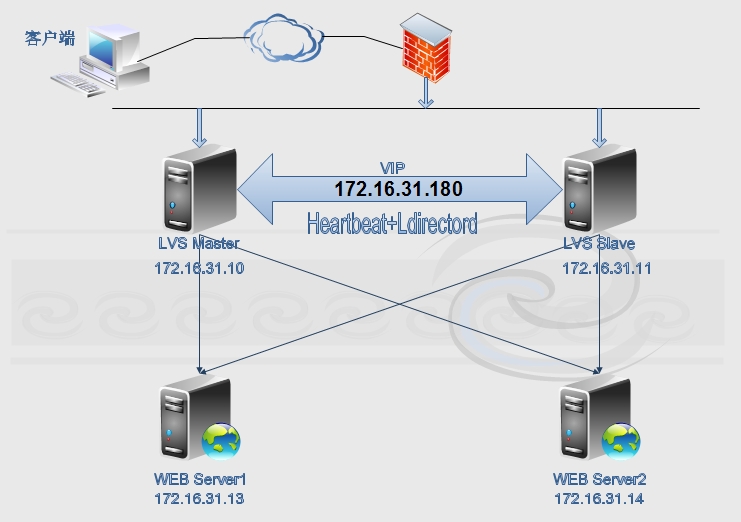
网络规划:
两台LVS server:(两台LVS也可以为用户提供错误页面)
node1:172.16.31.10
node2:172.16.31.11
VIP:172.16.31.180
ipvs规则内包含2台Real Server:(后面的RS指的就是后端的web服务器)
rs1:172.16.31.13
rs2:172.16.31.14
我们还需要错误页面提供者:我们选择LVS作为sorry server,所有的real server不可用时就指向这个sorry server。
一.配置HA集群前提:
1、节点之间时间必须同步;
建议使用ntp协议进行;
2、节点之间必须要通过主机名互相通信;
建议使用hosts文件;
通信中使用的名字必须与其节点为上“uname -n”命令展示出的名字保持一致;
3、如果是2个节点,需要仲裁设备;
4、节点之间彼此root用户能基于ssh密钥方式进行通信;
HA节点之间传递公钥:node1和node2配置,实现ssh无密钥通信
[root@node1 ~]# ssh-keygen -t rsa -P"" [root@node1 ~]# ssh-copy-id -i .ssh/id_rsa.pub root@node2 [root@node2 ~]# ssh-keygen -t rsa -P"" [root@node2 ~]# ssh-copy-id -i .ssh/id_rsa.pub root@node1
四个节点的hosts文件相同:
[root@node1 ~]# cat /etc/hosts 127.0.0.1 localhost localhost.localdomain localhost4 localhost4.localdomain4 ::1 localhost localhost.localdomain localhost6 localhost6.localdomain6 172.16.0.1 server.magelinux.com server 172.16.31.10 node1.stu31.com node1 172.16.31.11 node2.stu31.com node2 172.16.31.13 rs1.stu31.com rs1 172.16.31.14 rs2.stu31.com rs2
HA节点间实现无密钥通信:测试时间一致
[root@node1 ~]# date;ssh node2 'date' Sun Jan 4 17:57:51 CST 2015 Sun Jan 4 17:57:50 CST 2015
二.安装heartbeat
1.在LVS高可用集群安装heartbeat:
获取heartbeat程序包组:
[root@node1 heartbeat2]# ls heartbeat-2.1.4-12.el6.x86_64.rpm heartbeat-gui-2.1.4-12.el6.x86_64.rpm heartbeat-stonith-2.1.4-12.el6.x86_64.rpm heartbeat-ldirectord-2.1.4-12.el6.x86_64.rpm heartbeat-pils-2.1.4-12.el6.x86_64.rpm
安装程序包组:
node1和node2都需要安装;
前提条件需要安装如下依赖包:
[root@node1 heartbeat2]# yum install -ynet-snmp-libs libnet PyXML
3.安装heartbeat套件程序:
[root@node1 heartbeat2]# rpm -ivh heartbeat-2.1.4-12.el6.x86_64.rpm heartbeat-stonith-2.1.4-12.el6.x86_64.rpm heartbeat-pils-2.1.4-12.el6.x86_64.rpm heartbeat-gui- 2.1.4-12.el6.x86_64.rpm heartbeat-ldirectord-2.1.4-12.el6.x86_64.rpm error: Failed dependencies: ipvsadm is needed by heartbeat-ldirectord-2.1.4-12.el6.x86_64 perl(Mail::Send) is needed by heartbeat-ldirectord-2.1.4-12.el6.x86_64
有依赖关系,解决依赖关系:node1和node2都安装
# yum -y install ipvsadm perl-MailTools perl-TimeDate
再次安装:
# rpm -ivh heartbeat-2.1.4-12.el6.x86_64.rpm heartbeat-stonith-2.1.4-12.el6.x86_64.rpm heartbeat-pils-2.1.4-12.el6.x86_64.rpm heartbeat-gui-2.1.4-12.el6.x86_64.rpm heartbeat-ldirectord-2.1.4-12.el6.x86_64.rpm Preparing... ###########################################[100%] 1:heartbeat-pils ########################################### [ 20%] 2:heartbeat-stonith ########################################### [ 40%] 3:heartbeat ########################################### [ 60%] 4:heartbeat-gui ########################################### [ 80%] 5:heartbeat-ldirectord ########################################### [100%]
安装完成!
查看ldirectord生成的文件:
[root@node1 heartbeat2]# rpm -ql heartbeat-ldirectord /etc/ha.d/resource.d/ldirectord /etc/init.d/ldirectord /etc/logrotate.d/ldirectord /usr/sbin/ldirectord /usr/share/doc/heartbeat-ldirectord-2.1.4 /usr/share/doc/heartbeat-ldirectord-2.1.4/COPYING /usr/share/doc/heartbeat-ldirectord-2.1.4/README /usr/share/doc/heartbeat-ldirectord-2.1.4/ldirectord.cf /usr/share/man/man8/ldirectord.8.gz
存在模版配置文件。
ldirectord会自动检查后端Real Server的健康状态,实现按需添加或删除RS,还能定义sorry server;无需ipvsadm在LVS Server上定义,而是通过编辑ldirectord的配置文件来生成ipvs规则,因此,定义集群服务,添加RS都在配置文件中指定,而无须手动指向ipvsadm命令。
不用启动ipvs.
三.heartbeat配置:
1.系统日志记录heartbeat日志
[root@node1 ha.d]# vim /etc/rsyslog.conf #添加如下行: local0.* /var/log/heartbeat.log 拷贝一份到node2: [root@node1 ha.d]# scp /etc/rsyslog.confnode2:/etc/rsyslog.conf
2.拷贝配置文件模版到/etc/ha.d目录
[root@node1 ha.d]# cd /usr/share/doc/heartbeat-2.1.4/ [root@node1 heartbeat-2.1.4]# cp authkeysha.cf /etc/ha.d/
主配置文件:
[root@node1 ha.d]# grep -v ^# /etc/ha.d/ha.cf logfacility local0 mcast eth0 225.231.123.31 694 1 0 auto_failback on node node1.stu31.com node node2.stu31.com ping 172.16.0.1 crm on
认证文件:
[root@node1 ha.d]# vim authkeys auth 2 2 sha1 password
权限必须是600或者400:
[root@node1 ha.d]# chmod 600 authkeys
将主配置文件和认证文件拷贝到node2
[root@node1 ha.d]# scp authkeys ha.cf node2:/etc/ha.d/ authkeys 100% 675 0.7KB/s 00:00 ha.cf 100% 10KB 10.4KB/s 00:00 [root@node1 ha.d]#
四.配置RS Server:即WEB服务器
1.提供了一个脚本:
[root@rs1 ~]# cat rs.sh #!/bin/bash vip=172.16.31.180 interface="lo:0" case $1 in start) echo 2 > /proc/sys/net/ipv4/conf/all/arp_announce echo 2 > /proc/sys/net/ipv4/conf/lo/arp_announce echo 1 > /proc/sys/net/ipv4/conf/lo/arp_ignore echo 1 > /proc/sys/net/ipv4/conf/all/arp_ignore ifconfig $interface $vip broadcast $vip netmask 255.255.255.255 up route add -host $vip dev $interface ;; stop) echo 0 > /proc/sys/net/ipv4/conf/all/arp_announce echo 0 > /proc/sys/net/ipv4/conf/lo/arp_announce echo 0 > /proc/sys/net/ipv4/conf/lo/arp_ignore echo 0 > /proc/sys/net/ipv4/conf/all/arp_ignore ifconfig $interface down ;; status) if ficonfig lo:0 |grep $vip &>/dev/null; then echo "ipvs isrunning." else echo "ipvs isstopped." fi ;; *) echo "Usage 'basename $0 start|stop|status" exit 1 ;; esac
在两台RS 上执行启动。
保证RS能提供WEB服务:
[root@rs1 ~]# echo "rs1.stu31.com" > /var/www/html/index.html [root@rs2 ~]# echo "rs2.stu31.com" > /var/www/html/index.html
启动httpd服务测试:
[root@rs1 ~]# service httpd start Starting httpd: [ OK ] [root@rs1 ~]# curl http://172.16.31.13 rs1.stu31.com [root@rs2 ~]# service httpd start Starting httpd: [ OK ] [root@rs2 ~]# curl http://172.16.31.14 rs2.stu31.com
测试完成后就将httpd服务停止,关闭自启动:
# service httpd stop # chkconfig httpd off
RS就设置好了。
五.下面开始配置LVS的高可用集群:
1.手动配置好lvs-dr负载均衡集群:
[root@node1 ~]# ifconfig eth0:0 172.16.31.180 broadcast 172.16.31.180 netmask 255.255.255.255 up [root@node1 ~]# route add -host 172.16.31.180 dev eth0:0 [root@node1 ~]# ipvsadm -C [root@node1 ~]# ipvsadm -A -t 172.16.31.180:80 -s rr [root@node1 ~]# ipvsadm -a -t 172.16.31.180:80 -r 172.16.31.13 -g [root@node1 ~]# ipvsadm -a -t 172.16.31.180:80 -r 172.16.31.14 -g [root@node1 ~]# ipvsadm -L -n IP Virtual Server version 1.2.1 (size=4096) Prot LocalAddress:Port Scheduler Flags -> RemoteAddress:Port Forward Weight ActiveConn InActConn TCP 172.16.31.180:80 rr -> 172.16.31.13:80 Route 1 0 0 -> 172.16.31.14:80 Route 1 0 0
2.访问测试:
[root@nfs ~]# curl http://172.16.31.180 rs2.stu31.com [root@nfs ~]# curl http://172.16.31.180 rs1.stu31.com
负载均衡实现了:
[root@node1 ~]# ipvsadm -L -n IP Virtual Server version 1.2.1 (size=4096) Prot LocalAddress:Port Scheduler Flags -> RemoteAddress:Port Forward Weight ActiveConn InActConn TCP 172.16.31.180:80 rr -> 172.16.31.13:80 Route 1 0 1 -> 172.16.31.14:80 Route 1 0 1
在节点上清除配置的规则:
[root@node1 ~]# ipvsadm -C [root@node1 ~]# route del -host 172.16.31.180 [root@node1 ~]# ifconfig eth0:0 down
第二个LVS Server也同样测试一遍,测试成功后清除配置的规则。
3.在LVS上设置错误页面:配置LVS为sorry server,为用户提供错误提示页
[root@node1 ~]# echo "sorry page fromlvs1" > /var/www/html/index.html [root@node2 ~]# echo "sorry page fromlvs2" > /var/www/html/index.html
启动web服务测试错误页面正常:
[root@node1 ha.d]# service httpd start Starting httpd: [ OK ] [root@node1 ha.d]# curl http://172.16.31.10 sorry page from lvs1 [root@node2 ~]# service httpd start Starting httpd: [ OK ] [root@node2 ~]# curl http://172.16.31.11 sorry page from lvs2
4.将LVS的两个节点配置为HA集群:
拷贝ldirectord软件安装后的配置文件模版:
[root@node1 ~]# cd /usr/share/doc/heartbeat-ldirectord-2.1.4/ [root@node1 heartbeat-ldirectord-2.1.4]# ls COPYING ldirectord.cf README [root@node1 heartbeat-ldirectord-2.1.4]# cp ldirectord.cf /etc/ha.d
[root@node1 ha.d]# grep -v ^# /etc/ha.d/ldirectord.cf #检测超时 checktimeout=3 #检测间隔 checkinterval=1 #重新载入客户机 autoreload=yes #real server 宕机后从lvs列表中删除,恢复后自动添加进列表 quiescent=yes #监听VIP地址80端口 virtual=172.16.31.180:80 #真正服务器的IP地址和端口,路由模式 real=172.16.31.13:80 gate real=172.16.31.14:80 gate #如果RS节点都宕机,则回切到本地环回口地址 fallback=127.0.0.1:80 gate #服务是http service=http #保存在RS的web根目录并且可以访问,通过它来判断RS是否存活 request=".health.html" #网页内容 receive="OK" #调度算法 scheduler=rr #persistent=600 #netmask=255.255.255.255 #检测协议 protocol=tcp #检测类型 checktype=negotiate #检测端口 checkport=80
我们需要指定这个健康检查页面,在后端RS server上配置:
[root@rs1 ~]# echo "OK" > /var/www/html/.health.html [root@rs2 ~]# echo "OK" > /var/www/html/.health.html
复制一份ldirectord.cf配置文件到node2:
[root@node1 ha.d]# scp ldirectord.cf node2:/etc/ha.d/ ldirectord.cf 100% 7553 7.4KB/s 00:00
启动heartbeat服务:
[root@node1 ha.d]# service heartbeat start;ssh node2 'service heartbeat start' Starting High-Availability services: Done. Starting High-Availability services: Done.
查看监听端口:
[root@node1 ha.d]# ss -tunl |grep 5560 tcp LISTEN 0 10 *:5560 *:*
六.资源配置
需要对heartbeat图形界面登录用户授权加密:node2也需要设置密码。
[root@node1 ~]# echo oracle |passwd --stdin hacluster Changing password for user hacluster. passwd: all authentication tokens updatedsuccessfully.
进入图形化配置端配置资源:
输入如下指令:需要桌面支持。
#hb_gui &
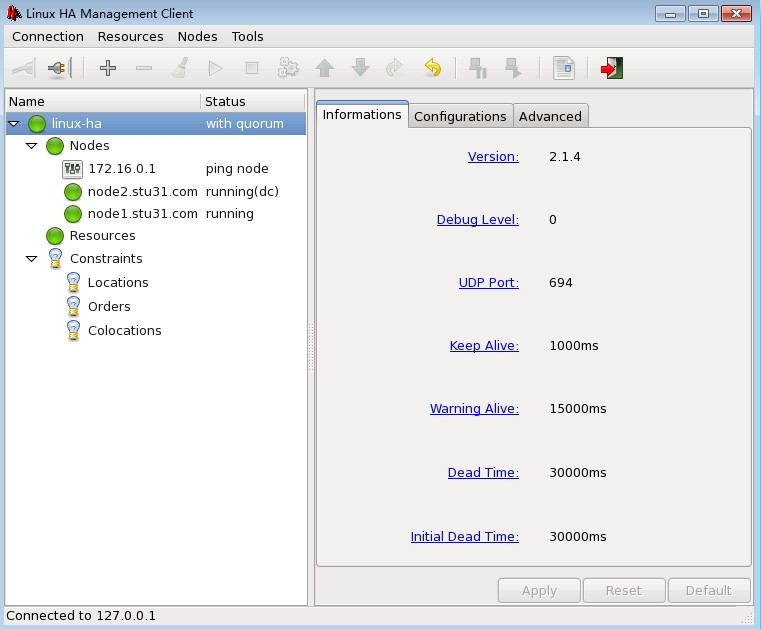
配置集群资源组:新建资源组
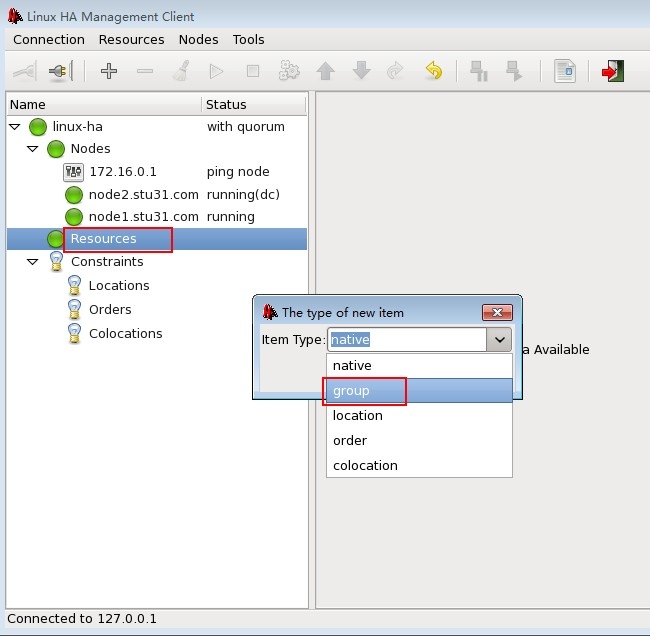
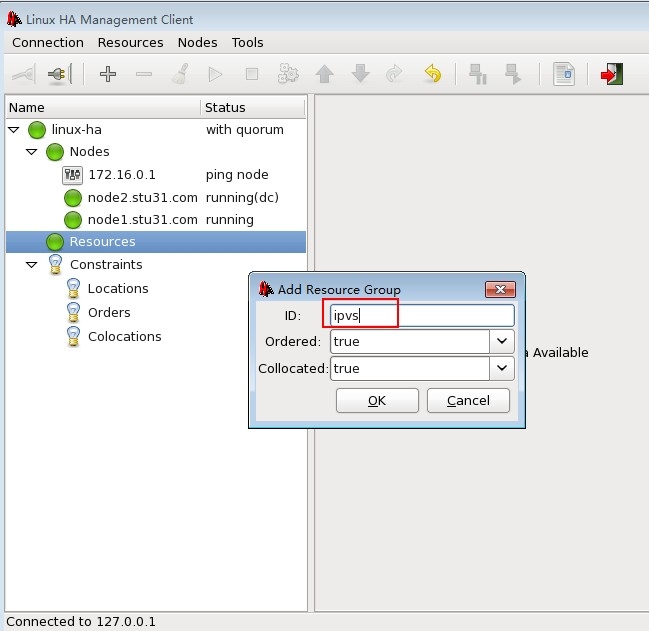
新建资源,VIP的定义:
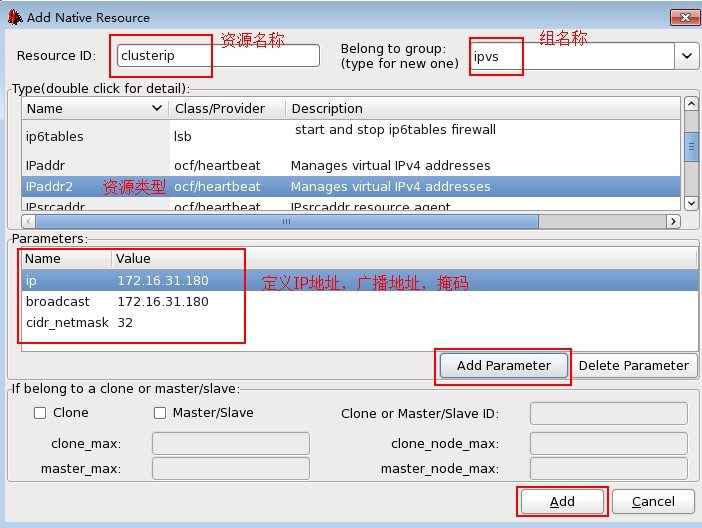
添加新资源:
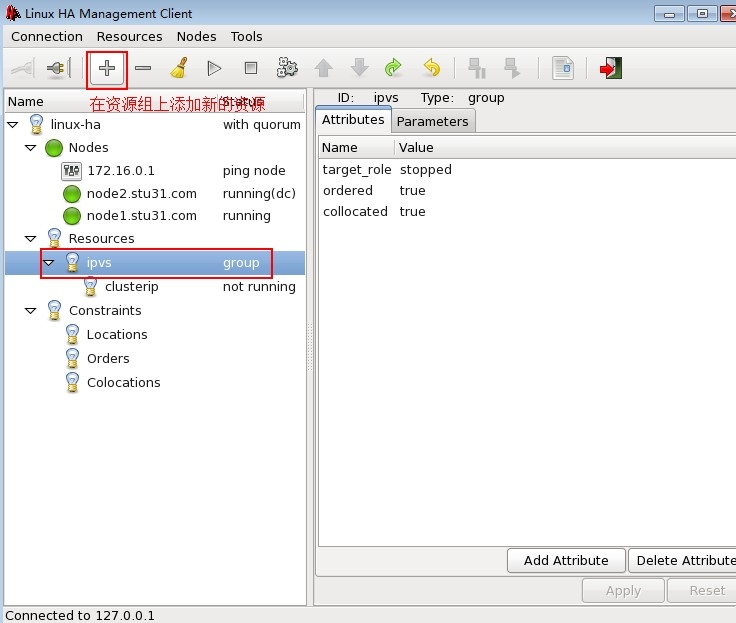

新建一个ipvs规则的资源:
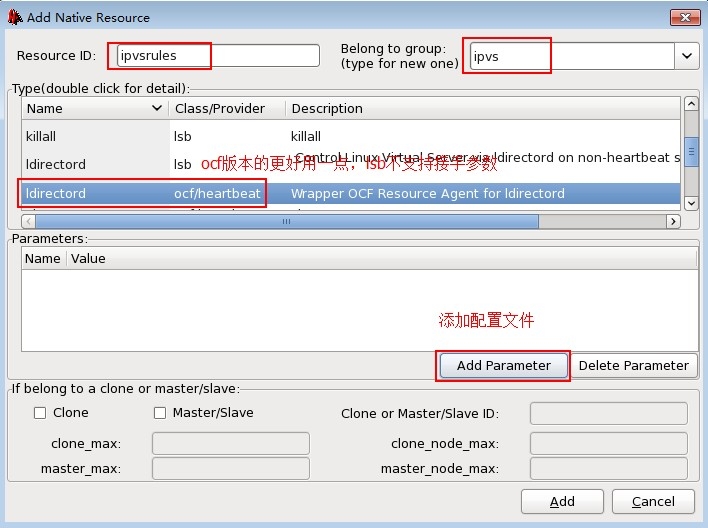
注意ldirecotord.cf这个配置文件在哪个目录:
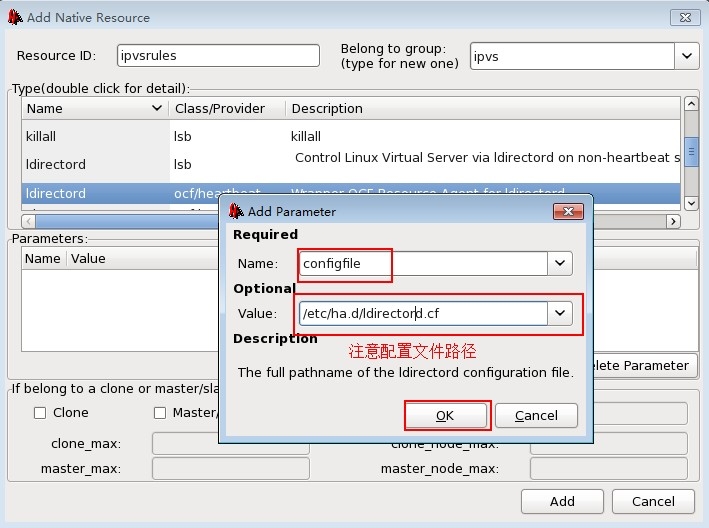
添加完成后就add:
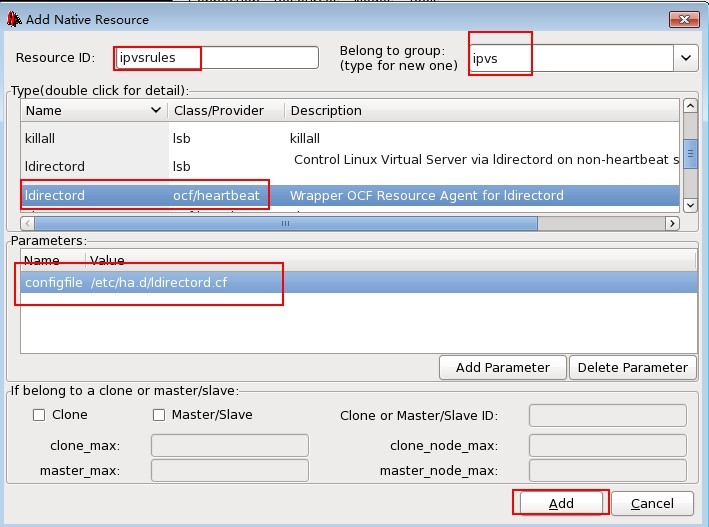
定义完成后就启动资源组ipvs:
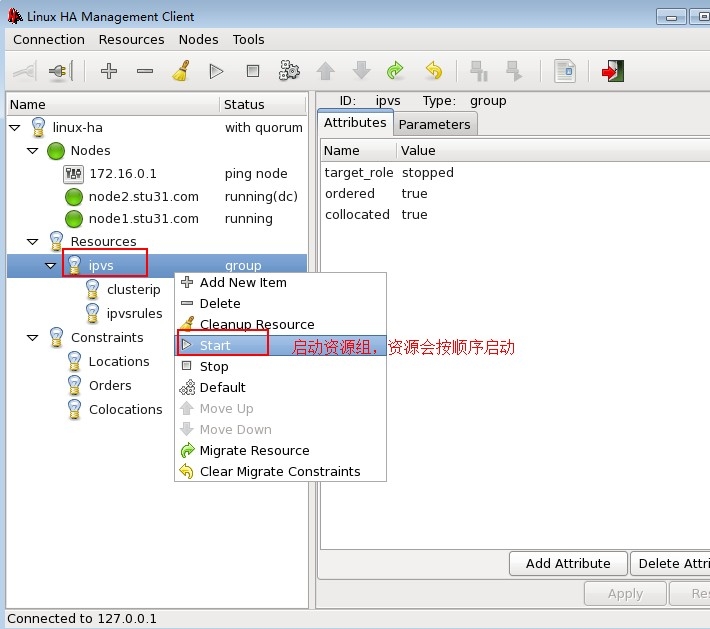
现在资源启动于node2:
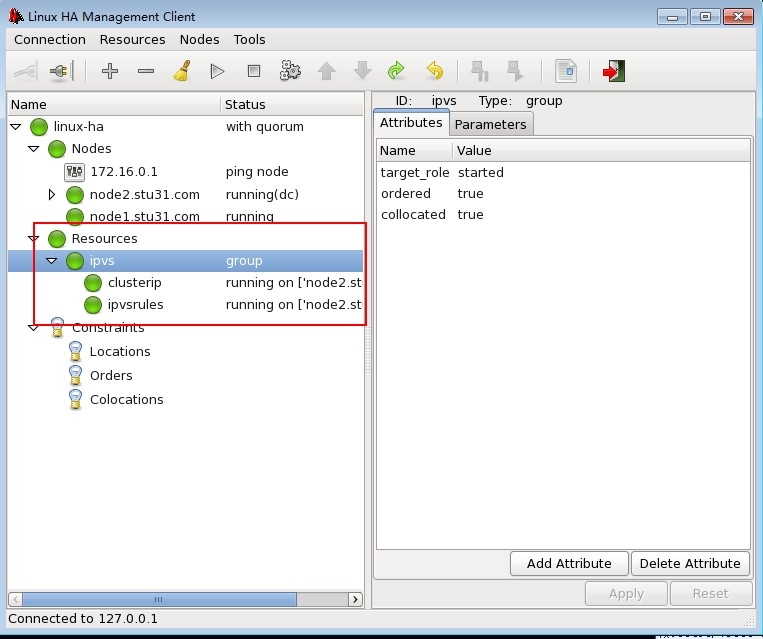
七.测试集群
我们去客户端请求两次:
[root@nfs ~]# curl http://172.16.31.180 rs2.stu31.com [root@nfs ~]# curl http://172.16.31.180 rs1.stu31.com
到node2上查看负载均衡状态信息:
[root@node2 ~]# ipvsadm -L -n IP Virtual Server version 1.2.1 (size=4096) Prot LocalAddress:Port Scheduler Flags -> RemoteAddress:Port Forward Weight ActiveConn InActConn TCP 172.16.31.180:80 rr -> 172.16.31.13:80 Route 1 0 1 -> 172.16.31.14:80 Route 1 0 1
我们将后端两台RS服务器的web健康监测页面改名后查看效果:
[root@rs1 ~]# cd /var/www/html/ [root@rs1 html]# mv .health.html a.html [root@rs2 ~]# cd /var/www/html/ [root@rs2 html]# mv .health.html a.html
使用客户端访问:
[root@nfs ~]# curl http://172.16.31.180 sorry page from lvs2
集群判断后端的RS都宕机了,就决定启用错误页面的web服务器,返回错误信息给用户。
在节点2上查看负载均衡状态信息:
[root@node2 ~]# ipvsadm -L -n IP Virtual Server version 1.2.1 (size=4096) Prot LocalAddress:Port Scheduler Flags -> RemoteAddress:Port Forward Weight ActiveConn InActConn TCP 172.16.31.180:80 rr -> 127.0.0.1:80 Local 1 0 1 -> 172.16.31.13:80 Route 0 0 0 -> 172.16.31.14:80 Route 0 0 0
将错误的RS服务器权重设置为0,将本地httpd服务的权重设为1.
我们再复原:
[root@rs1 html]# mv a.html .health.html [root@rs2 html]# mv a.html .health.html
访问测试:
[root@nfs ~]# curl http://172.16.31.180 rs2.stu31.com [root@nfs ~]# curl http://172.16.31.180 rs1.stu31.com
查看负载均衡状态信息:
[root@node2 ~]# ipvsadm -L -n IP Virtual Server version 1.2.1 (size=4096) Prot LocalAddress:Port Scheduler Flags -> RemoteAddress:Port Forward Weight ActiveConn InActConn TCP 172.16.31.180:80 rr -> 172.16.31.13:80 Route 1 0 1 -> 172.16.31.14:80 Route 1 0 1
测试成功。
进行节点切换测试:
将节点2设置为standby,备用节点。
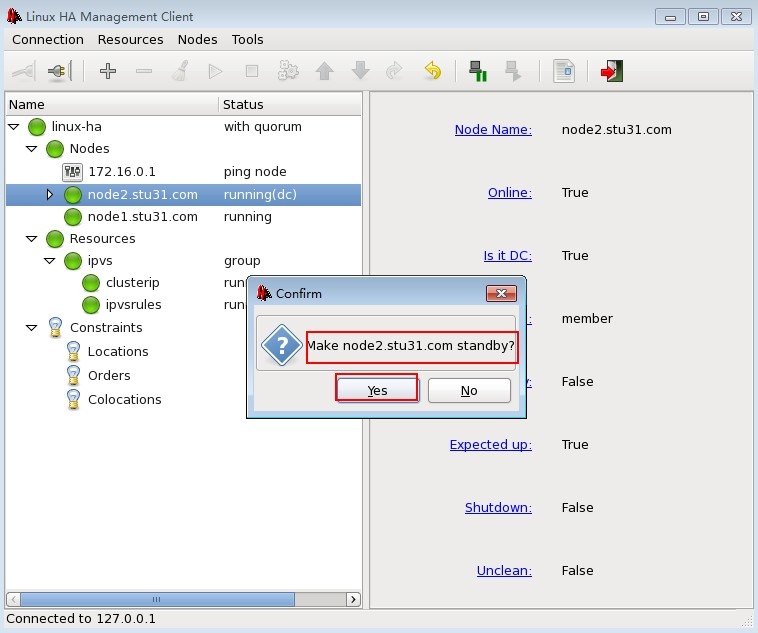
点击yes后,主节点就到node1启动了:
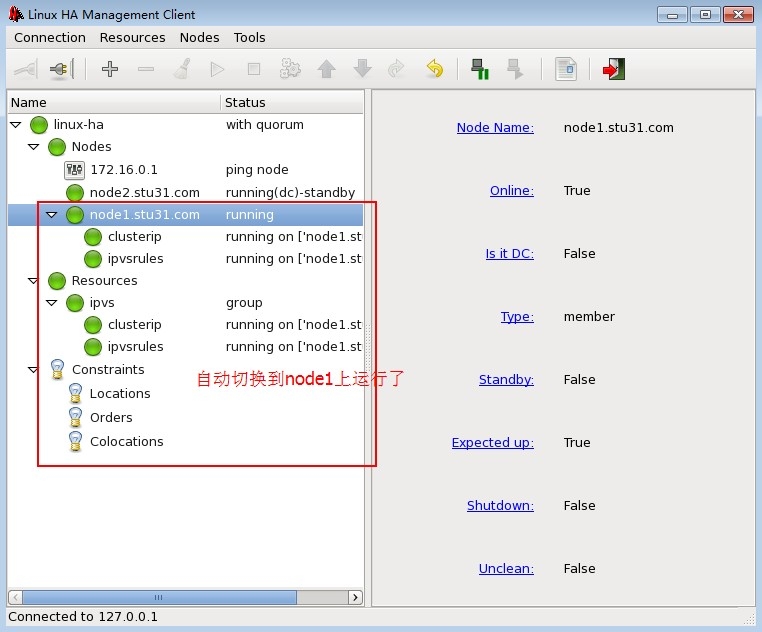
进行访问测试:
[root@nfs ~]# curl http://172.16.31.180 rs2.stu31.com [root@nfs ~]# curl http://172.16.31.180 rs1.stu31.com
到节点1查看负载均衡状态:
[root@node1 ~]# ipvsadm -L -n IP Virtual Server version 1.2.1 (size=4096) Prot LocalAddress:Port Scheduler Flags -> RemoteAddress:Port Forward Weight ActiveConn InActConn TCP 172.16.31.180:80 rr -> 172.16.31.13:80 Route 1 0 1 -> 172.16.31.14:80 Route 1 0 1
至此,使用heartbeat的ldirectord组件构建ipvs负载均衡集群的高可用性集群就搭建完毕,可以实现集群对后端RS的监控。